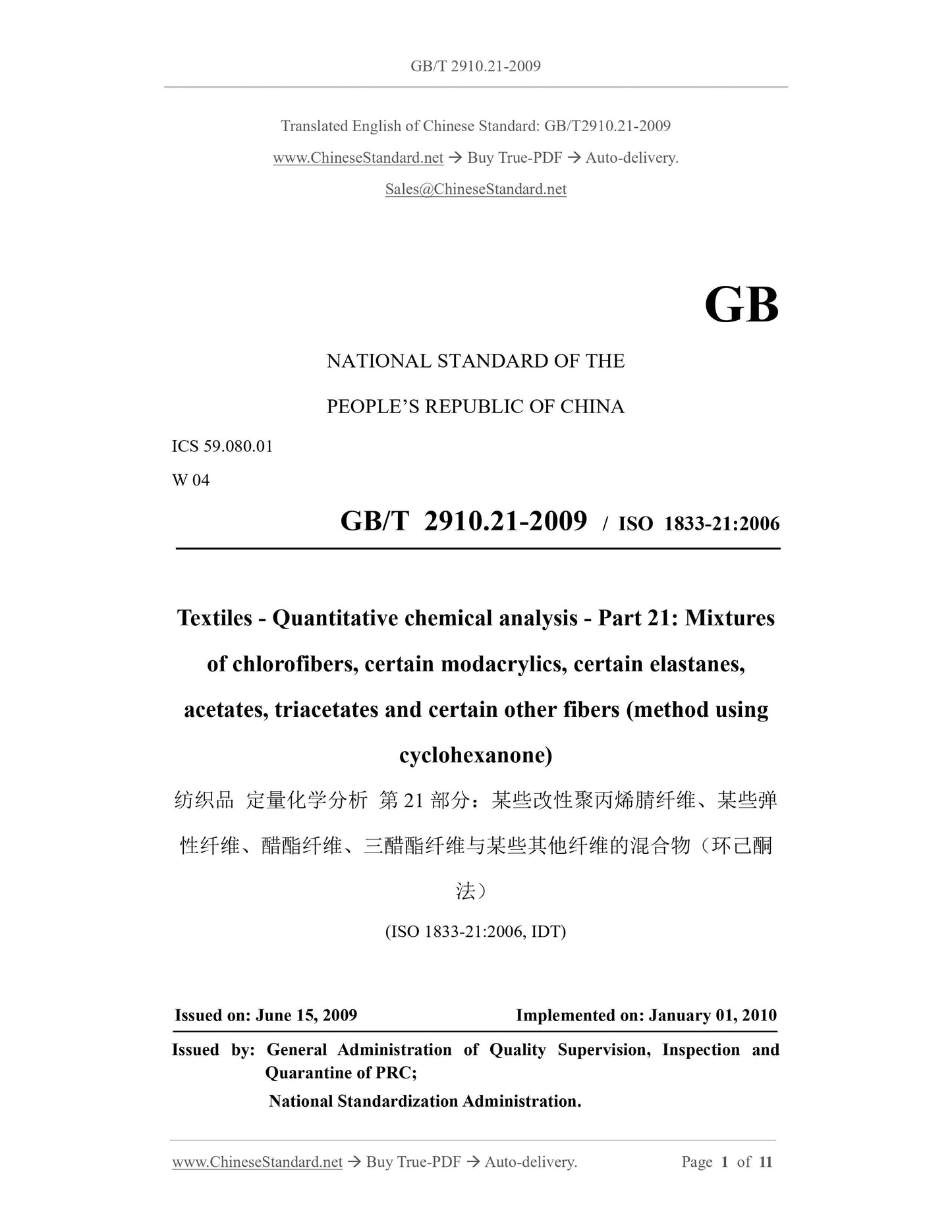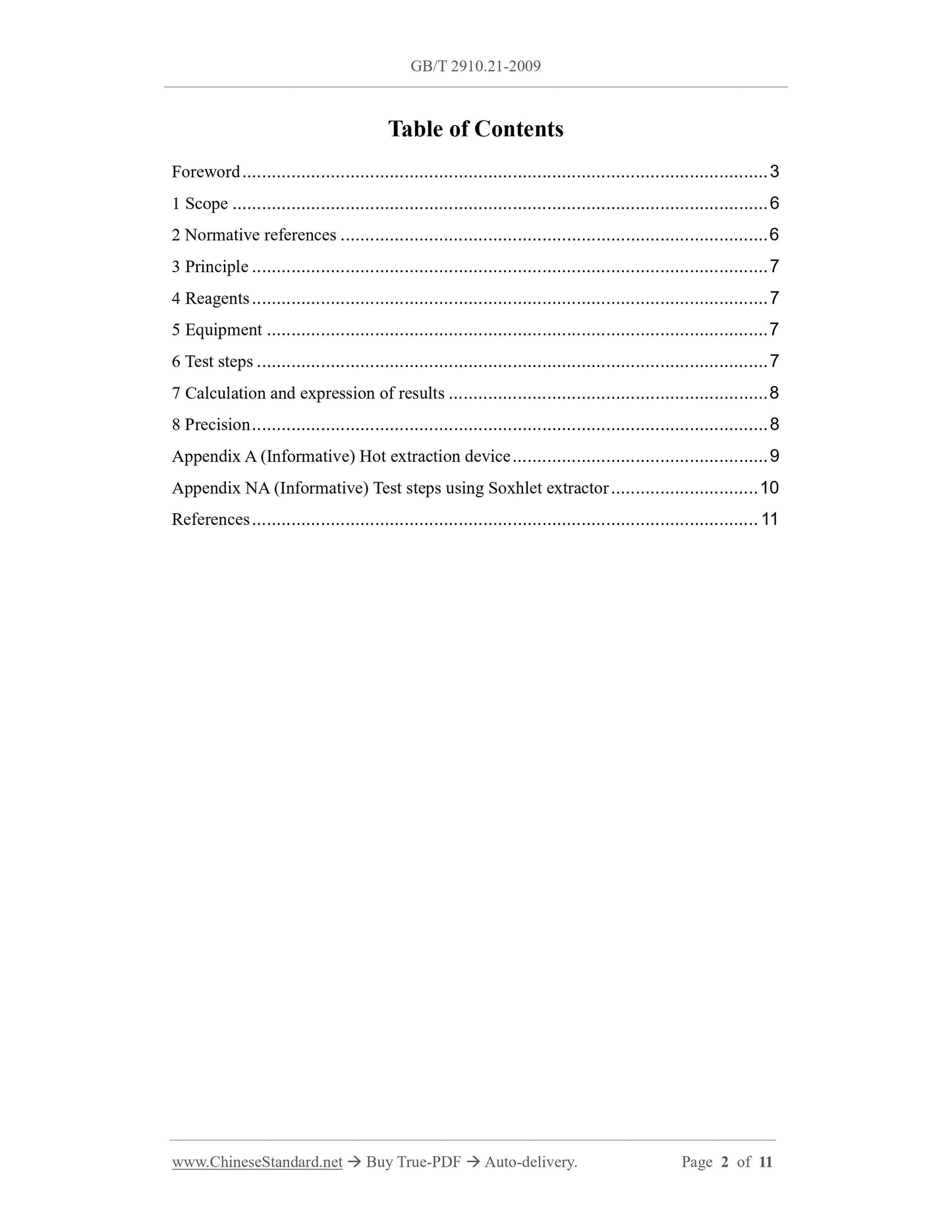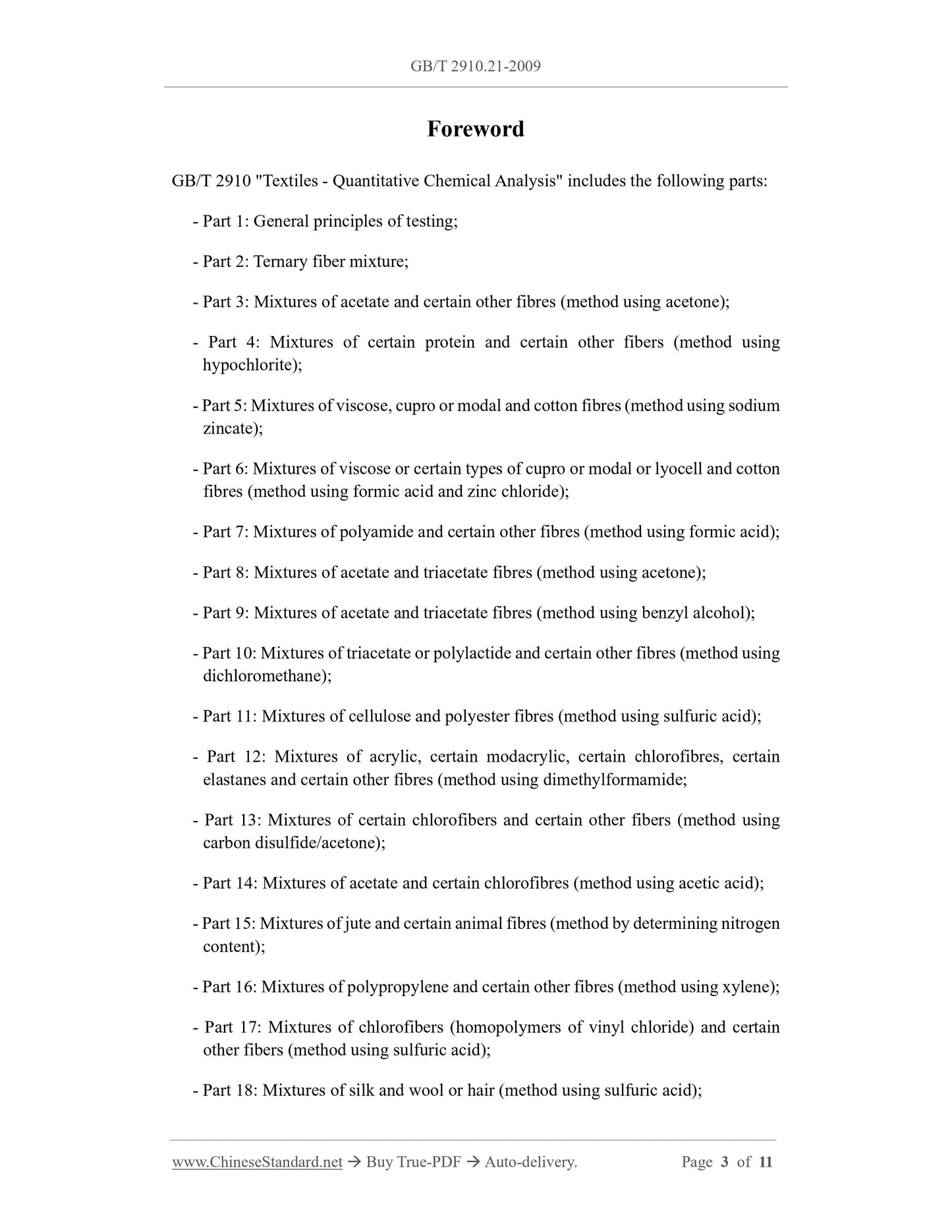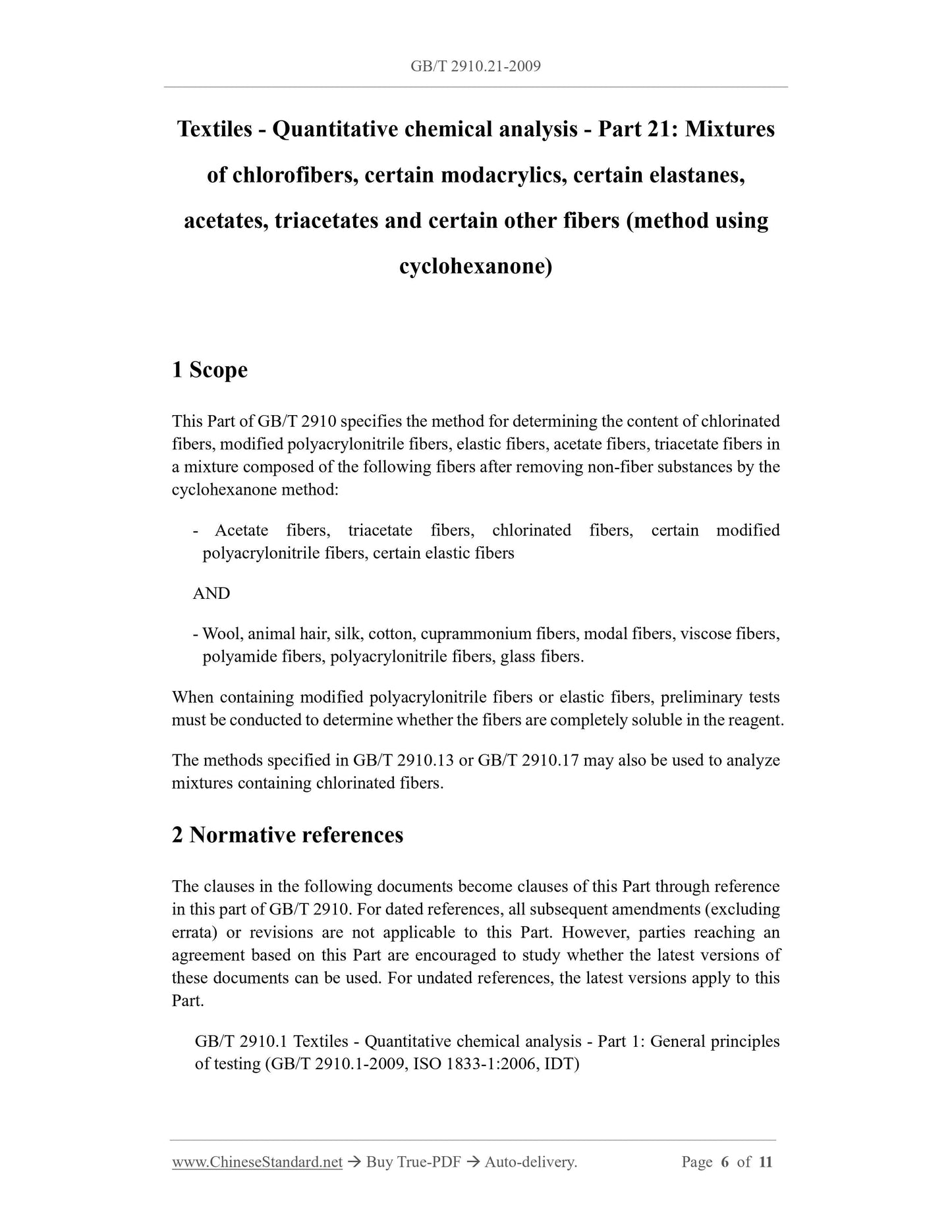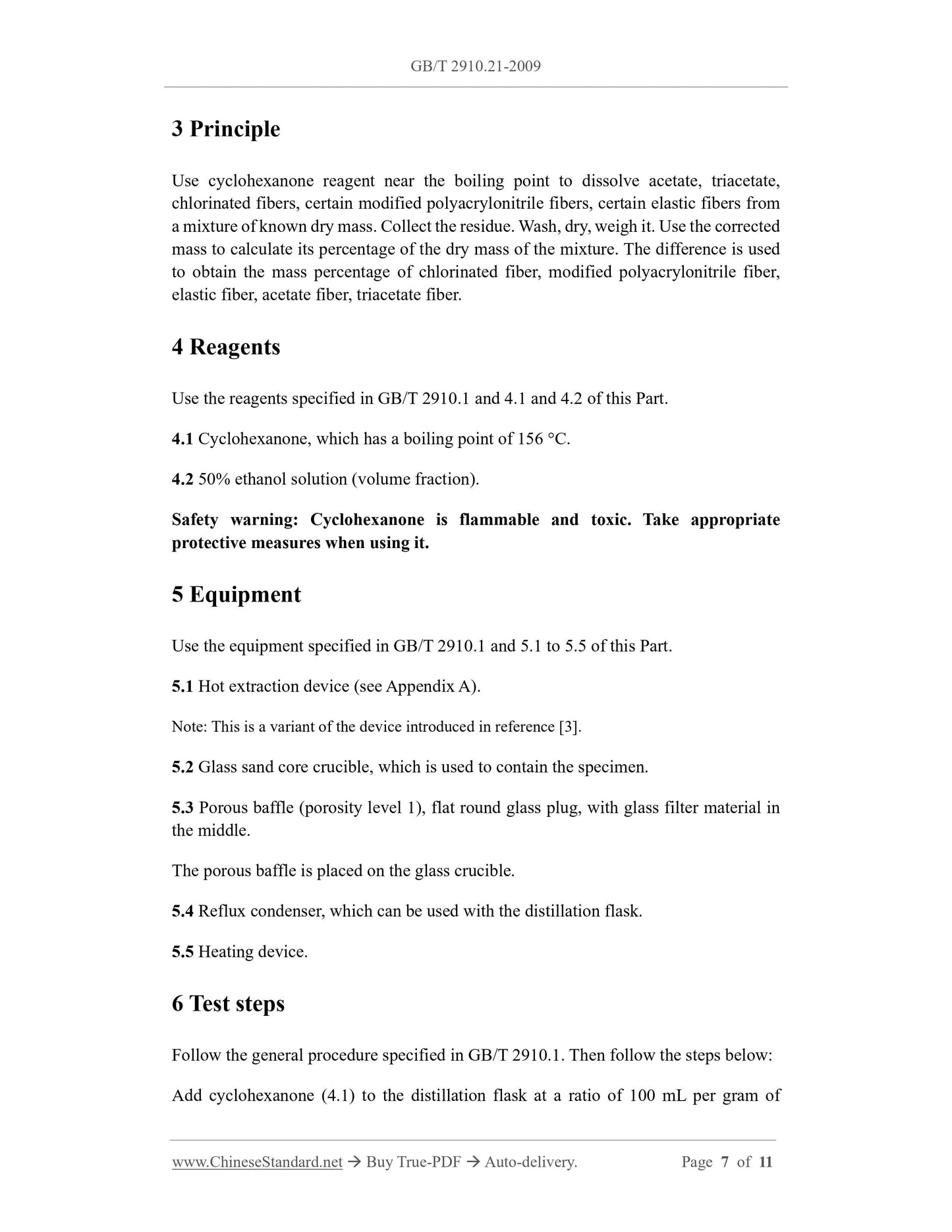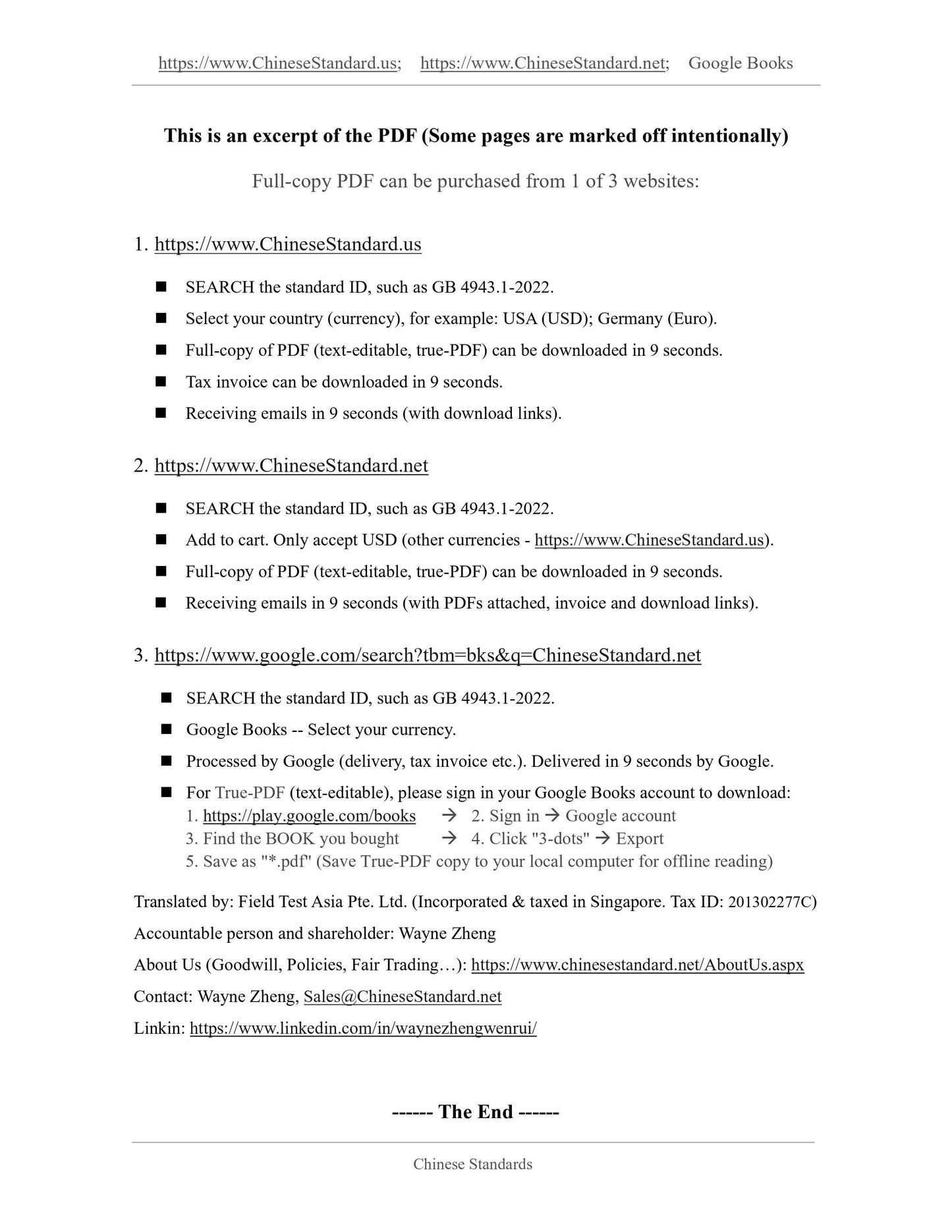1
/
of
6
PayPal, credit cards. Download editable-PDF and invoice in 1 second!
GB/T 2910.21-2009 English PDF (GBT2910.21-2009)
GB/T 2910.21-2009 English PDF (GBT2910.21-2009)
Regular price
$70.00 USD
Regular price
Sale price
$70.00 USD
Unit price
/
per
Shipping calculated at checkout.
Couldn't load pickup availability
Delivery: 3 seconds. Download true-PDF + Invoice.
Get QUOTATION in 1-minute: Click GB/T 2910.21-2009
Historical versions: GB/T 2910.21-2009
Preview True-PDF (Reload/Scroll if blank)
GB/T 2910.21-2009: Textiles -- Quantitative chemical analysis -- Part 21: Mixtures of chlorofibre, certain modacrylics, certain elastane, acetates, triacetates and certain other fibers (method of using dimethylacetamide)
GB/T 2910.21-2009
GB
NATIONAL STANDARD OF THE
PEOPLE’S REPUBLIC OF CHINA
ICS 59.080.01
W 04
GB/T 2910.21-2009 / ISO 1833-21.2006
Textiles - Quantitative chemical analysis - Part 21.Mixtures
of chlorofibers, certain modacrylics, certain elastanes,
acetates, triacetates and certain other fibers (method using
cyclohexanone)
(ISO 1833-21.2006, IDT)
ISSUED ON. JUNE 15, 2009
IMPLEMENTED ON. JANUARY 01, 2010
Issued by. General Administration of Quality Supervision, Inspection and
Quarantine of PRC;
National Standardization Administration.
Table of Contents
Foreword... 3
1 Scope... 6
2 Normative references... 6
3 Principle... 7
4 Reagents... 7
5 Equipment... 7
6 Test steps... 7
7 Calculation and expression of results... 8
8 Precision... 8
Appendix A (Informative) Hot extraction device... 9
Appendix NA (Informative) Test steps using Soxhlet extractor... 10
References... 11
Foreword
GB/T 2910 "Textiles - Quantitative Chemical Analysis" includes the following parts.
- Part 1.General principles of testing;
- Part 2.Ternary fiber mixture;
- Part 3.Mixtures of acetate and certain other fibres (method using acetone);
- Part 4.Mixtures of certain protein and certain other fibers (method using
hypochlorite);
- Part 5.Mixtures of viscose, cupro or modal and cotton fibres (method using sodium
zincate);
- Part 6.Mixtures of viscose or certain types of cupro or modal or lyocell and cotton
fibres (method using formic acid and zinc chloride);
- Part 7.Mixtures of polyamide and certain other fibres (method using formic acid);
- Part 8.Mixtures of acetate and triacetate fibres (method using acetone);
- Part 9.Mixtures of acetate and triacetate fibres (method using benzyl alcohol);
- Part 10.Mixtures of triacetate or polylactide and certain other fibres (method using
dichloromethane);
- Part 11.Mixtures of cellulose and polyester fibres (method using sulfuric acid);
- Part 12.Mixtures of acrylic, certain modacrylic, certain chlorofibres, certain
elastanes and certain other fibres (method using dimethylformamide;
- Part 13.Mixtures of certain chlorofibers and certain other fibers (method using
carbon disulfide/acetone);
- Part 14.Mixtures of acetate and certain chlorofibres (method using acetic acid);
- Part 15.Mixtures of jute and certain animal fibres (method by determining nitrogen
content);
- Part 16.Mixtures of polypropylene and certain other fibres (method using xylene);
- Part 17.Mixtures of chlorofibers (homopolymers of vinyl chloride) and certain
other fibers (method using sulfuric acid);
- Part 18.Mixtures of silk and wool or hair (method using sulfuric acid);
Textiles - Quantitative chemical analysis - Part 21.Mixtures
of chlorofibers, certain modacrylics, certain elastanes,
acetates, triacetates and certain other fibers (method using
cyclohexanone)
1 Scope
This Part of GB/T 2910 specifies the method for determining the content of chlorinated
fibers, modified polyacrylonitrile fibers, elastic fibers, acetate fibers, triacetate fibers in
a mixture composed of the following fibers after removing non-fiber substances by the
cyclohexanone method.
- Acetate fibers, triacetate fibers, chlorinated fibers, certain modified
polyacrylonitrile fibers, certain elastic fibers
AND
- Wool, animal hair, silk, cotton, cuprammonium fibers, modal fibers, viscose fibers,
polyamide fibers, polyacrylonitrile fibers, glass fibers.
When containing modified polyacrylonitrile fibers or elastic fibers, preliminary tests
must be conducted to determine whether the fibers are completely soluble in the reagent.
The methods specified in GB/T 2910.13 or GB/T 2910.17 may also be used to analyze
mixtures containing chlorinated fibers.
2 Normative references
The clauses in the following documents become clauses of this Part through reference
in this part of GB/T 2910.For dated references, all subsequent amendments (excluding
errata) or revisions are not applicable to this Part. However, parties reaching an
agreement based on this Part are encouraged to study whether the latest versions of
these documents can be used. For undated references, the latest versions apply to this
Part.
GB/T 2910.1 Textiles - Quantitative chemical analysis - Part 1.General principles
of testing (GB/T 2910.1-2009, ISO 1833-1.2006, IDT)
3 Principle
Use cyclohexanone reagent near the boiling point to dissolve acetate, triacetate,
chlorinated fibers, certain modified polyacrylonitrile fibers, certain elastic fibers from
a mixture of known dry mass. Collect the residue. Wash, dry, weigh it. Use the corrected
mass to calculate its percentage of the dry mass of the mixture. The difference is used
to obtain the mass percentage of chlorinated fiber, modified polyacrylonitrile fiber,
elastic fiber, acetate fiber, triacetate fiber.
4 Reagents
Use the reagents specified in GB/T 2910.1 and 4.1 and 4.2 of this Part.
4.1 Cyclohexanone, which has a boiling point of 156 °C.
4.2 50% ethanol solution (volume fraction).
Safety warning. Cyclohexanone is flammable and toxic. Take appropriate
protective measures when using it.
5 Equipment
Use the equipment specified in GB/T 2910.1 and 5.1 to 5.5 of this Part.
5.1 Hot extraction device (see Appendix A).
Note. This is a variant of the device introduced in reference [3].
5.2 Glass sand core crucible, which is used to contain the specimen.
5.3 Porous baffle (porosity level 1), flat round glass plug, with glass filter material in
the middle.
The porous baffle is placed on the glass crucible.
5.4 Reflux condenser, which can be used with the distillation flask.
5.5 Heating device.
6 Test steps
Follow the general procedure specified in GB/T 2910.1.Then follow the steps below.
Add cyclohexanone (4.1) to the distillation flask at a ratio of 100 mL per gram of
Get QUOTATION in 1-minute: Click GB/T 2910.21-2009
Historical versions: GB/T 2910.21-2009
Preview True-PDF (Reload/Scroll if blank)
GB/T 2910.21-2009: Textiles -- Quantitative chemical analysis -- Part 21: Mixtures of chlorofibre, certain modacrylics, certain elastane, acetates, triacetates and certain other fibers (method of using dimethylacetamide)
GB/T 2910.21-2009
GB
NATIONAL STANDARD OF THE
PEOPLE’S REPUBLIC OF CHINA
ICS 59.080.01
W 04
GB/T 2910.21-2009 / ISO 1833-21.2006
Textiles - Quantitative chemical analysis - Part 21.Mixtures
of chlorofibers, certain modacrylics, certain elastanes,
acetates, triacetates and certain other fibers (method using
cyclohexanone)
(ISO 1833-21.2006, IDT)
ISSUED ON. JUNE 15, 2009
IMPLEMENTED ON. JANUARY 01, 2010
Issued by. General Administration of Quality Supervision, Inspection and
Quarantine of PRC;
National Standardization Administration.
Table of Contents
Foreword... 3
1 Scope... 6
2 Normative references... 6
3 Principle... 7
4 Reagents... 7
5 Equipment... 7
6 Test steps... 7
7 Calculation and expression of results... 8
8 Precision... 8
Appendix A (Informative) Hot extraction device... 9
Appendix NA (Informative) Test steps using Soxhlet extractor... 10
References... 11
Foreword
GB/T 2910 "Textiles - Quantitative Chemical Analysis" includes the following parts.
- Part 1.General principles of testing;
- Part 2.Ternary fiber mixture;
- Part 3.Mixtures of acetate and certain other fibres (method using acetone);
- Part 4.Mixtures of certain protein and certain other fibers (method using
hypochlorite);
- Part 5.Mixtures of viscose, cupro or modal and cotton fibres (method using sodium
zincate);
- Part 6.Mixtures of viscose or certain types of cupro or modal or lyocell and cotton
fibres (method using formic acid and zinc chloride);
- Part 7.Mixtures of polyamide and certain other fibres (method using formic acid);
- Part 8.Mixtures of acetate and triacetate fibres (method using acetone);
- Part 9.Mixtures of acetate and triacetate fibres (method using benzyl alcohol);
- Part 10.Mixtures of triacetate or polylactide and certain other fibres (method using
dichloromethane);
- Part 11.Mixtures of cellulose and polyester fibres (method using sulfuric acid);
- Part 12.Mixtures of acrylic, certain modacrylic, certain chlorofibres, certain
elastanes and certain other fibres (method using dimethylformamide;
- Part 13.Mixtures of certain chlorofibers and certain other fibers (method using
carbon disulfide/acetone);
- Part 14.Mixtures of acetate and certain chlorofibres (method using acetic acid);
- Part 15.Mixtures of jute and certain animal fibres (method by determining nitrogen
content);
- Part 16.Mixtures of polypropylene and certain other fibres (method using xylene);
- Part 17.Mixtures of chlorofibers (homopolymers of vinyl chloride) and certain
other fibers (method using sulfuric acid);
- Part 18.Mixtures of silk and wool or hair (method using sulfuric acid);
Textiles - Quantitative chemical analysis - Part 21.Mixtures
of chlorofibers, certain modacrylics, certain elastanes,
acetates, triacetates and certain other fibers (method using
cyclohexanone)
1 Scope
This Part of GB/T 2910 specifies the method for determining the content of chlorinated
fibers, modified polyacrylonitrile fibers, elastic fibers, acetate fibers, triacetate fibers in
a mixture composed of the following fibers after removing non-fiber substances by the
cyclohexanone method.
- Acetate fibers, triacetate fibers, chlorinated fibers, certain modified
polyacrylonitrile fibers, certain elastic fibers
AND
- Wool, animal hair, silk, cotton, cuprammonium fibers, modal fibers, viscose fibers,
polyamide fibers, polyacrylonitrile fibers, glass fibers.
When containing modified polyacrylonitrile fibers or elastic fibers, preliminary tests
must be conducted to determine whether the fibers are completely soluble in the reagent.
The methods specified in GB/T 2910.13 or GB/T 2910.17 may also be used to analyze
mixtures containing chlorinated fibers.
2 Normative references
The clauses in the following documents become clauses of this Part through reference
in this part of GB/T 2910.For dated references, all subsequent amendments (excluding
errata) or revisions are not applicable to this Part. However, parties reaching an
agreement based on this Part are encouraged to study whether the latest versions of
these documents can be used. For undated references, the latest versions apply to this
Part.
GB/T 2910.1 Textiles - Quantitative chemical analysis - Part 1.General principles
of testing (GB/T 2910.1-2009, ISO 1833-1.2006, IDT)
3 Principle
Use cyclohexanone reagent near the boiling point to dissolve acetate, triacetate,
chlorinated fibers, certain modified polyacrylonitrile fibers, certain elastic fibers from
a mixture of known dry mass. Collect the residue. Wash, dry, weigh it. Use the corrected
mass to calculate its percentage of the dry mass of the mixture. The difference is used
to obtain the mass percentage of chlorinated fiber, modified polyacrylonitrile fiber,
elastic fiber, acetate fiber, triacetate fiber.
4 Reagents
Use the reagents specified in GB/T 2910.1 and 4.1 and 4.2 of this Part.
4.1 Cyclohexanone, which has a boiling point of 156 °C.
4.2 50% ethanol solution (volume fraction).
Safety warning. Cyclohexanone is flammable and toxic. Take appropriate
protective measures when using it.
5 Equipment
Use the equipment specified in GB/T 2910.1 and 5.1 to 5.5 of this Part.
5.1 Hot extraction device (see Appendix A).
Note. This is a variant of the device introduced in reference [3].
5.2 Glass sand core crucible, which is used to contain the specimen.
5.3 Porous baffle (porosity level 1), flat round glass plug, with glass filter material in
the middle.
The porous baffle is placed on the glass crucible.
5.4 Reflux condenser, which can be used with the distillation flask.
5.5 Heating device.
6 Test steps
Follow the general procedure specified in GB/T 2910.1.Then follow the steps below.
Add cyclohexanone (4.1) to the distillation flask at a ratio of 100 mL per gram of
Share
